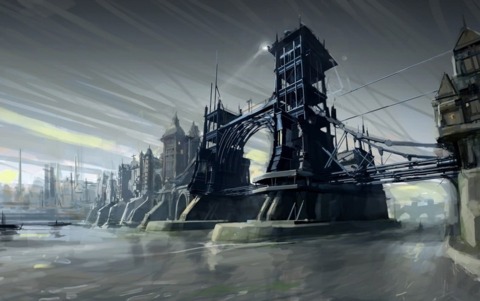Arkane, id, Insomniac devs share their origin stories
QuakeCon 2011: Harvey Smith, Raphael Colantonio, Matt Hooper, and Marcus Smith discuss their gaming start and how their roots shape their work today.
Who was there: At the QuakeCon 2011 panel, Harvey Smith, co-creative director at Arkane Studios; Raphael Colantonio, co-creative director and president of Arkane Studios; Matt Hooper, design director at id Software; and Marcus Smith, design director at Insomniac Studios all met to discuss their video game origins. The panel was moderated by Game Informer magazine senior editor Andrew Reiner.

What they talked about: Instead of being bitten by radioactive insects or inheriting magic rings, the four game developers at this panel each had an origin story rooted in long afternoons spent with the likes of Quake or Ultima. Reiner jumped straight to the heart of the issue by asking the panelists what games got them into the video game industry. Harvey and Hooper both cited the Atari 2600, saying it was a driving influence in their lives simply because of the joy they experienced by being able to interact with objects on a screen.
When pressed for specifics, Harvey chose Adventure on the 2600 because of the game's sense of exploration. Hooper chose Doom and Quake for largely the same reason. Sticking with the theme of adventure, Colantonio chose Ultima II as one of the early games that really hooked him on the medium, while Marcus decided to go ever further back with Pong. Despite having different selections, all of the panelists felt strongly about the feeling they had when exploring a new in-game world for the first time. This could be in a 3D environment, or something as simple as a text-based adventure.
Moving toward the present, Reiner asked the panelists if becoming a game creator had changed the way they looked at other video games. Harvey spoke first, saying that when you start making games you can't help but "raise the curtain" and analyze how certain sections are put together from a technical perspective. But he also made sure to add that this has never hurt his love for games.
Marcus also chimed in and said that he had been reverse-engineering games even before he became a developer. To surmount Out of this World or the original Prince of Persia, it was almost necessary to draw out certain areas of the game and study how they were constructed.
The discussion then turned to creating gameworlds that feel alive. Colantonio said that it all starts with something grounded in reality that grows into something more supernatural. For example, with Dishonored, the team at Arkane started with 16th-century London and then began layering on "what if" scenarios. But even though the end product is a world wildly different from our own, having that grounded starting point helped maintain a sense of cohesion--a feeling that the world makes sense within its own context.
Harking back to the original question, Reiner polled each of the panelists on what made certain games special. Harvey went first and talked about his experiences with Carrier Command growing up. He talked about how mind-blowing it was swapping between commanding the ship and piloting the smaller vehicles and how all that came together to make a really immersive game. Colantonio was next and reflected on how impressed he was that the non-player characters in the Ultima series all had daily routines they would follow and their patterns weren't just random.
Marcus was put on the spot and asked how Super Mario Bros. had influenced the development of Resistance. Speaking in broad terms, the developer stated that while the Mario games are linear experiences, they don't force you down one path or another. Instead, they give you some tools and have you approach the game's challenges in numerous ways. With Resistance, Marcus said, the team tried to do something similar. Finally, Hooper brought up Half-Life and talked about how developer Valve didn't feel as if it had to drag the player through every story sequence. It just presented the story and trusted that it was compelling enough to hold the player's attention.
After closing this topic, the panelists were asked to run through some of the modern games they felt were really shaping game development today. BioShock, Batman: Arkham Asylum, and Minecraft all came up as very well-crafted games. A brief talk on multiplayer favorites followed, before the floor was opened up for a Q&A session. When asked about why the industry doesn't see more games taking creative risks and breaking the mold, Hooper spoke up and said it's tricky when a large game can take hundreds of millions of dollars to make. He added that back in the early years of game development, taking these risks was easier since the amount of money, manpower, and time was lower.
Harvey chimed in and added that the "garage band groups" are still alive and well. He cited games such as Braid and From Dust as being smaller games that offered something really unique and was glad such games have so many distribution options in today's gaming market.
Quote: "If it wasn't for piracy, I wouldn't be in the games industry."--Marcus Smith, talking about his video game upbringing.
"I modeled a Pizza Hut."--Matt Hooper, talking about working with Doom's modding tools.
Takeaway: The panelists commented that they often get asked which games directly influenced the development of the ones they're currently working on. However, the truth is that it isn't easy to cite one specific game as a direct influence. Most of the time, it's only a small scene or gameplay feature, rather than an entire game, that really influences someone. And it's these collections of tiny influences that guide and shape the games we play today.
Got a news tip or want to contact us directly? Email news@gamespot.com
Join the conversation